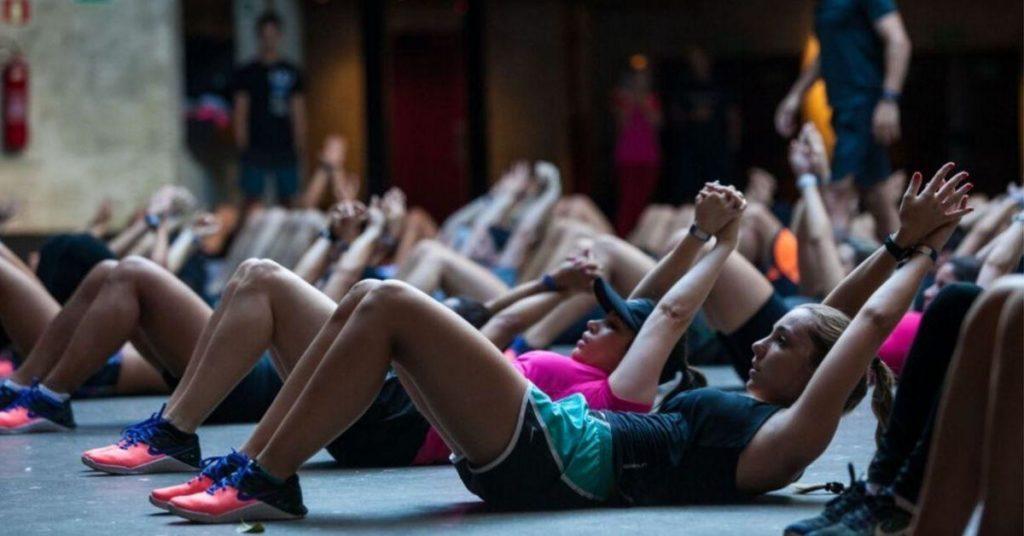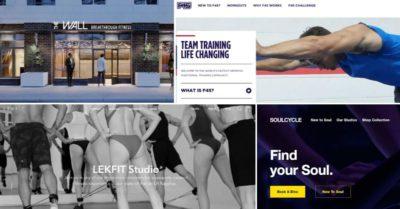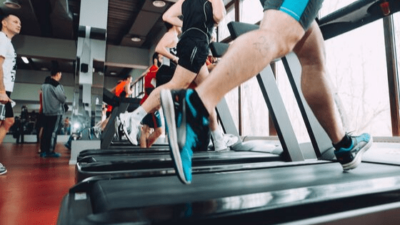There’s no question that group workouts are growing in popularity. Noted as a fitness trend that we’ll be seeing even more of in 2020, they offer a fun and convenient way for people to exercise and deliver a sense of community.
As outlined in 8 reasons your gym needs to offer group training; there’s a host of benefits to providing this type of class. Plus, you can tap into a new market that you might not be reaching already. If your studio is new to the idea of group fitness, it can be hard to know where to start. In this article, we’ll outline how to create group workout programs that’ll keep your members happy, motivated, and coming back for more.
Skip ahead to:
Build a Community with Group Workouts
There are a ton of benefits for both your business and your members in group workouts. Compared to a gym-only member; exercisers are 26% less likely to cancel a group class, and 35% remain loyal compared to 29% of gym attendees.
Group training is an opportunity for your members to become part of a community. This will increase your retention and beyond fitness goals; the sense of belonging is what will keep your members turning up to class and coming back. However, a community won’t build itself! It’s up to you to foster this kind of environment. Here are 4 ways to develop and maintain a sense of community with group fitness at your gym.
1. Personalize Your Service
Get to know your class members individually. It will build a sense of trust, make them feel appreciated, and help you bring everyone together. Once you establish regular members for the class, you could introduce a ‘member of the month’ feature. Create a profile detailing their fitness progress so far at your studio. Add some information about their life outside of the gym; this can help members get to know each other better.
2. Create a Challenge
Get your members feeling motivated and excited to work out in your class – create a class-based challenge that pulls everyone together. Keep the task simple; the goal here is to encourage a bit of light-hearted competition. At the end of the class, for example, split members into two groups. Choose a basic exercise, like jumping jacks, that everyone’s comfortable with and have the teams complete it for as long as they can. The first team with someone to stop looses.
3. Offer a Referral Program for the Class
You may already have an effective referral scheme in place, but there’s nothing wrong with tailoring one specifically to your classes. Try hosting a bring a friend week, where members can bring a friend along for free. Some people find going to a class for the first time intimidating, but going together with a friend makes it more accessible. It’s a great way to allow a new prospect to get a taste of the class.
4. Use Social Media
Get your members involved and engaged outside of your studio! Post photos of your group in class and tag their social accounts, or share them on your Instagram stories. If they’re engaging with and resharing the content, it’s essentially free marketing for your business.
Plan Your Program
When you start planning the physical exercises that you want to include in your program, you’ll need to consider the format. Think about elements like how long the class should be and what part of your studio will work best for group workouts.
Structure
Try to keep classes at a 6:1 ratio of members to trainers to make sure everyone has the best experience. A good structure for group workouts helps coaches get the best out of members and enables members to create a foundation for more advanced training later on.
For example, many group classes like HIIT workouts follow a timed interval formula as it’s a great way to get everyone working up a sweat and keep training engaging and fun. But this wouldn’t be right the setup to teach members more sophisticated techniques. For teaching these moves, experiment with a format that lets members hold a movement or execute it slowly and steadily so they can understand the method and how to perform it right.
Warmups
All group workouts should start with a warm-up. It gets the muscles ready for exercise, and it’s also great for getting members in the right mindset to take on the class. What you choose for your warmups will depend on the class. As a guide, plan a 5-10 minute dynamic warm-up focusing on the following areas:
Loosen up. Focus on the muscles and parts of the body that will be getting used most during the class. This is also an excellent time to check if your members have any injuries or tighter muscles that you might want to focus on – you could incorporate foam rollers as part of the warmup to help.
Stretch. When your members aren’t exercising, most will spend a lot of their day hunched at a desk; putting a strain on their knees, hips, and spine. Incorporate movements that extend, stretch, and lengthen, especially in areas like the back and hamstrings.
Full range of motion. As above, many people are sedentary throughout the day, so its good to get all of the joints moving. Even something as simple as jump squats is perfect for this.
Coaches
Not everyone can train large groups of people; group exercise is very different from personal training. Group exercise will bring together people of all different fitness levels, and things can get hectic!
If you plan on teaching the class yourself and are comfortable in your ability, you’re off to a strong start. If a staff member will be taking the class, have them give a demo class beforehand so you can see if they’re suited to the role. The best way to get comfortable is with practice, and you can learn how to teach a great class by taking part in different classes yourself to see how it’s done.
The Customer
Engagement Playbook
for Your Fitness
Business
Discover more 3 Program Ideas for Group Workouts
A safe and effective group workout needs to include a variety of exercises to address different areas and muscle groups. Let’s begin with some warm-up ideas to get everyone going.
8 Dynamic Warmup Exercises
Complete the activities below for 30 seconds each. You can swap some options out, or change them up, depending on the space you have to work with.
- Jumping jacks
- Hamstring stretch
- Walking nee hugs
- Side shuffles
- Squat to stands
- Back peddling
- Leg swings
- Inchworms
Think about combining a mixture of aerobic, strength training, and flexibility exercises to improve long-term fitness. It’s easiest to split workouts into categories, as it helps to narrow down what practices you’ll use in the class. To give an outline of a program guide for group workouts, let’s say you’re offering 3 classes a week. One will be a density day, one will be for metabolic conditioning, and one will focus on strength.
1. Density Workout
A density workout is based on how much you’re able to do in a set amount of time. High-intensity interval training is a great structure to use for this type of group exercise. Try formatting the class to include 30 seconds on each exercise, for two rounds, then a 15-second rest. This is a pretty straightforward structure to follow; it will make keeping an eye on all of your members easier and free you up to help them if need be.
This video from Heather Robertson is a good example that you can adapt to suit your class; we’ve listed some exercises you can swap in below. The video includes a 5-minute warmup.
Video workout round 1:
- Knee drive (R)
- Knee drive (L)
- Jack press
- Russian twists
- 1 arm swing (R)
- 1 arm swing (L)
- Boxer burpee
Alternative exercises to incorporate:
- Battle Ropes
- Dumbbell chainsaw row (right arm)
- Dumbbell chainsaw row (left arm)
- Battle Ropes
- Butterfly crunches
- Ball slams
- Air bike
- Wallball toss
- Battle Ropes
- Lunges
2. Metabolic Conditioning
Metabolic conditioning involves intense, quick burst exercises to maximize calorie burn; both during and after your workout. This workout from Tone and Tighten is a good example to get you started. The video uses a 30-second interval format with 7 exercises. We’ve also outlined an example of a program you can split between two groups below.
This format is best suited to a class of members who’ve tried HIIT workouts before, as it uses intense drills. Set a time frame of 12 minutes and have members work through the exercises at each station as many times as they can before time’s up.
Station 1
- Deadlifts x 12
- Russian twists x 30
- Pushups x 12
- Bent over dumbbell row x 12 (each arm)
Station 2
- Barbell squats x 8
- Dumbbell bench press x 8
- Renegade rows x 8 (4 each side)
- Kettlebell side bends x 12
Finishing round
3 rounds at 30 seconds each
- Kettlebell squats
- Mountain climbers
- Ball slams side to side
3. Strength Training
Strength training focuses on resistance to contract the muscles. Long-term, this improves bone density and anaerobic endurance. (And of course, strength). This 30-minute workout from Bodybuilding.com outlines a simple yet effective strength workout that you can easily adapt to suit a group.
We’ve outlined another example group workout for strength training below, for this, you’ll need to set up two stations. Split your class into two groups and have them swap over after 15 minutes. You can adapt the method where you need to, depending on how many members you have in a class. This mainly applies to the finishing rounds, so we’ve outlined a few examples to choose from for this section. These exercises should be steady, with members move straight on to something the next round.
Station 1
- Deadlift x 6
- Pull-up x 6
- Kettlebell swings x 12
- Burpees x 6
Station 2
- Kettlebell single leg deadlift x 8 (each leg)
- Push press x 8
- Cable X row x 8
- Shoulder taps x 30
Finishing round
3 rounds at 30 seconds each.
- Battle ropes
- Sled pushes
- Ball slams
- Dumbbell squats
In Summary
Group workouts are at the heart of boutique fitness, and we know that this is more than a fitness fad. Boutique fitness has reshaped the fitness industry and with it; changed the way people are working out. Venturing into group exercise is an exciting time for any fitness business owner. It’s a trend that’s only getting bigger, so even if you start small, it’s a concept you need to embrace. If you do it right, you’ll see new referrals coming in, and your retention rates increase. And you’ll ask yourself why you didn’t offer group fitness sooner!
The Customer
Engagement Playbook
for Your Fitness
Business
connects with its customers on a deeper level than a
simple business and consumer relationship.








